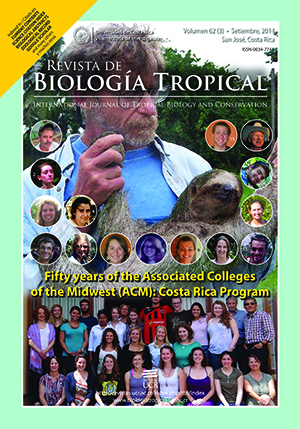Abstract
Leishmaniosis is an important human disease very difficult to treat. For this reason, many researchers in the world have been looking for anti-leishmanial chemical components present in several plant species. In Costa Rica, since no studies have been done in this field, this work aimed at the search of active chemical components in local plants that may have an activity against Leishmania sp. A total of 67 plants were selected from the Alberto Manuel Brenes Biological Reserve (REBAMB). For these collected plants, fresh or dried hidroalcoholic extracts of root, stem, mature or young leaves, flowers, and immature or mature fruits, were prepared under conventional methods. All extracts were tested for their effect against a strain of Leishmania (OCR with known characteristics). Firstly, by presumptive tests, we selected only those with some activity, and then, more specific studies were done to determine the IC50 in µg/mL; a promising plant was considered only if at least one of its parts presented an IC50<100µg/mL. Under this parameter, the following active plants were obtained and their lowest and highest IC50 obtained values presented (µ/mL): Bocconia frutescens (0.6 y 66.7), Clematis dioica (27.5 y 44.4), Cordia megalantha (80), Eugenia austin-smithi (90.6), Guarea bullata (98.8), Guateria tonduzii (44.4 y 66.3), Mikania holwayana (45 y 95.6), Nectandra membranacea (44.5 y 58.6), Neurolaena lobata (25 y 100), Persea povedae (76.9), Piper auritum (60), Rollinia pittieri (43.1), Solanum arboreum (25.8 y 72.5), Tetrorchidium euryphyllum (53.8 y 95), Witheringia solanacea (15.9 y 98.1) and Zanthoxylum juniperinum (23.4 y 97.5). Although the parasitic effect of fresh or dried extracts were almost similar, the fresh material slightly showed better results. That anti-parasitic effect occurred in one or more than four parts of the plant. Most of the active extracts did not produce lysis and aglutination which indicates a low toxicity. Since the species studied are different from those analyzed by other authors, we discuss the importance of these new findings, in relation to the new scientific knowledge, and the possible use of these plants as a leishmaniosis treatment.
##plugins.facebook.comentarios##

This work is licensed under a Creative Commons Attribution 4.0 International License.
Copyright (c) 2014 Revista de Biología Tropical






